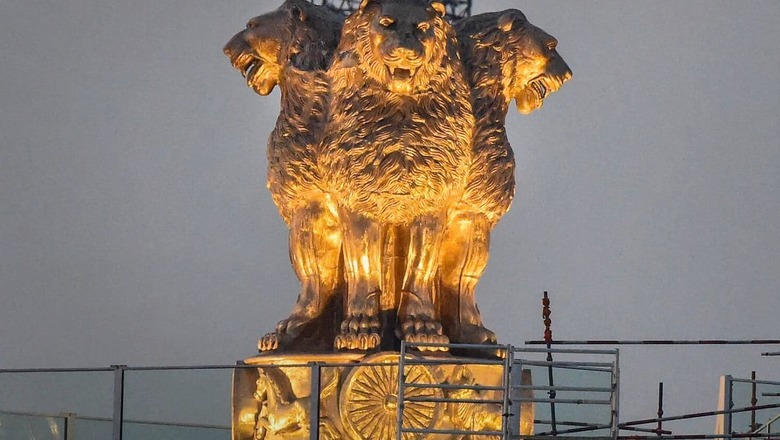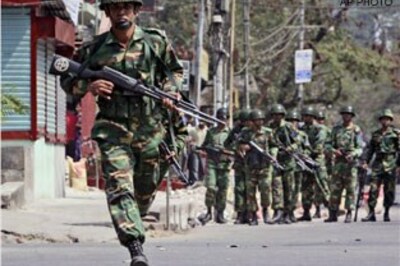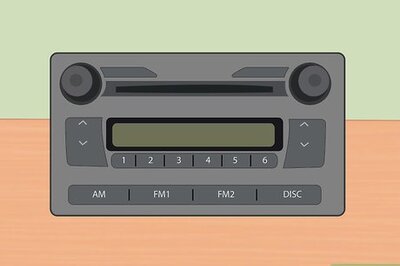
views
The Lion Capital of Ashoka is a sculpture of four Asiatic lions standing back to back on an elaborate base that includes other animals. A graphic representation of it was adopted as the official Emblem of India in 1950. It was originally placed on the top of the Ashoka pillar by the Emperor Ashoka, in about 250 BCE, during his rule over the Maurya Empire. The pillar, also called the Ashoka Column, is still in its original location, but the Lion Capital is now in the Sarnath Museum in the state of Uttar Pradesh.
Standing 2.15 metres (7 feet) high, including the base, it is more elaborate than the other, very similar surviving capitals of the pillars of Ashoka bearing his edicts that were placed throughout India, several of which feature single animals at the top; one other damaged group of four lions survives at Sanchi.
The Lion Capital is carved out of a single block of polished sandstone and was always a separate piece from the column itself. It features four Asiatic lions standing back to back. They are mounted on a circular abacus, with the frieze of the abacus adorned with sculptures in high relief, of an elephant, a galloping horse, a bull, and a lion, separated by intervening spoked chariot wheels.
The Lion is symbolic of the 24th Tirthankara Mahavira’s symbol. Further, the Bull, the Elephant and the Horse are sequentially symbolic of the first three Tirthankaras — Rishabhanatha, Ajitanatha and Sambhavanatha respectively. The whole sits upon a bell-shaped lotus. The Capital was originally crowned by a ‘Wheel of Dharma’ (Dharmachakra popularly known in India as the “Ashoka Chakra”), with 24 spokes, of which a few fragments were found on the site. A 13th-century replica of the Sarnath pillar and capital in Wat Umong near Chiang Mai, Thailand, built by King Mangrai, preserves its crowning Ashoka Chakra or Dharmachakra. The wheel on the Capital, below the lions, is the model for the one in the flag of India.
A 6.5-metre-long bronze National Emblem cast unveiled by Prime Minister Narendra Modi on the roof of the new Parliament building in New Delhi recently became the subject of a completely needless controversy, stoked by an Opposition that has been electorally vanquished by the Modi government again and again and again.
The Opposition alleges that the lions on the Emblem are more aggressive looking, more ferocious looking with red fangs and an expanded chest. However, the artists who sculpted these lions have refuted the baseless allegations, saying the iconic design of Sarnath was completely adhered to.
The Congress called the “deviation” in the design an “insult” to the Emblem. Congress MP Jairam Ramesh tweeted, “To completely change the character and nature of the lions on Ashoka’s pillar at Sarnath is nothing but a brazen insult to India’s national symbol”.
But Sunil Deore and Romiel Moses, who designed the 9,500-kg bronze Emblem, have said there is “no deviation” in design.
“We’ve paid attention to detail. The character of lions is the same. There may be very minor differences. People may have different interpretations. It is a large statue, and a view from below may give a distorted impression,” Deore said.
It is obvious that the new structure, which is at a height of 33 metres from the ground, compared to the original structure, which is almost at ground level, will look much bigger in dimension. When the standalone weight of the new structure is 9,500 kg, it is but natural that the impact of angle, height, size and proportion will come into play, making every aspect of the new structure look much bigger and wider, including the mouth of the lions.
But the basic character of both the old and new structures essentially remains the same. The simple point is that after being left with no political capital, the Opposition — particularly the Congress — is desperate for attention and is looking at any opportunity to put the Modi government in the dock, even if it is something as inane as the degree of ferocity of lions.
Are lions supposed to be demure, coy, mild-mannered, unsure, sheepish, cowardly? Certainly not! A lion is the king of the jungle and is aggressive, sure-footed, super-confident, brave, courageous and moves around with tremendous pride. The New India under Prime Minister Narendra Modi is also aggressively marching towards becoming a $5 trillion economy with a majestic pride and confidence that comes with the achievement of being not only the world’s fastest growing economy but also the world’s largest and vibrantly functional democracy.
PM Modi inaugurated the 9,500kg bronze structure at a ceremony on July 11, which was also attended by Lok Sabha Speaker Om Birla, Union ministers Hardeep Puri and Pralhad Joshi, Rajya Sabha deputy chairman Harivansh Singh, and others. The Opposition is now sulking that it was not invited to this ceremony whereas the hard truth is that for the ‘Bhoomi Pujan’ of the new Parliament building in December 2020, invites were sent out to Opposition leaders like Ghulam Nabi Azad and Adhir Ranjan Chowdhury. Both boycotted the ceremony.
Again in November 2021, 14 opposition parties boycotted the Constitution Day function in the Central hall of Parliament after making absolutely false and baseless allegations that the government was riding roughshod over the Constitution in matters of governance and law-making. The event was attended by President Ram Nath Kovind and PM Narendra Modi among others but barring a few MPs from the BJD and AIADMK, no other Opposition party chose to register its presence.
Hence, for the Opposition to now allege that they were not invited, smacks of rabid hypocrisy. Take the case of Mamata Banerjee, for example, who is a repeat offender. She chose to stay away from the Rabindranath Tagore Jayanti celebrations last year in May and then had the audacity to say the Modi government had not invited her, despite proof of invitation sent out to her doing the rounds of social media, clearly calling out Didi’s bluff. Mamata Banerjee also chose to walk away in a huff during the Parakram Diwas celebrations few months back to celebrate Netaji Bose’s birth anniversary on January 23, 2021.
In December 2020, PM Modi had performed ‘bhoomi pujan’ for the new Parliament with six Hindu priests. He sat with the priests, worshipping Lord Ganesha and Lord Vishnu. Lok Sabha Speaker and the Deputy Chairman, senior ministers in the government, MPs and foreign dignitaries had watched the PM perform the rituals from a distance. Later, there was a prayer session involving holy persons from different religions like Buddhists, Jains, Sikhs, Muslims, Bahais, Jews and Parsis.
PM Modi is an immensely proud Hindu and he wears that without any inhibitions on his equally proud sleeves. However, the lame argument that PM Modi only furthers the cause of Hindutva is hogwash. He has been equally at ease laying the foundation stone of the Ram Mandir at Ayodhya or gifting a “chaadar” at the Ajmer Dargah, or for that matter being the first PM in 70 years to visit the Pope at the Vatican in 2021.
Does the law of the land permit the government to amend the national Emblem? The relevant law to be considered with regard to the State Emblem would be the State Emblem of India (Prohibition of Improper Use) Act, 2005, and the State Emblem of India (Regulation of Use) Rules, 2007, which specifically deal with State Emblems. The schedule of the Act states that the State Emblem of India is an adaptation from the Sarnath Lion Capital of Asoka, which is preserved, and shall conform to the designs as set out in Appendix I or Appendix II.
Section 6(2)(f) of the same Act further, specifically states, “Subject to the provisions of this Act, the Central government shall have powers to do all such things (including the specification of design of the emblem and its use in the manner whatsoever) as the Central government considers necessary or expedient for the exercise of the foregoing powers.”
Therefore, to cut a long story short, as advocate Radhika Roy — lawyer at the Delhi High Court — says, the 2005 Act grants the central government the power under Section 6(2)(f) to institute changes in the specification of the design of the Emblem which is described and specified under the schedule and regulate manner of its use.
The only caveat is that the State Emblem of India must conform to the designs set out in Appendix I or II. Roy adds, “What flows from this is that not only does the central government have the power to stipulate the specification of the design of the Emblem, but there is nothing that prevents the Central government from changing the State Emblem completely by way of an amending Act.”
That is, of course, subject to approval by both the Houses, but at any point of time, some of the national symbols can be changed at the discretion of the legislature. Basically, the law authorised the central government to regulate the use of the Emblem, subject, of course, to some caveats. Hence the hue and cry by the Opposition, even from a legal standpoint, is nothing but mere noise from an electorally debilitated group that is desperately trying to gain relevance after being booted out in election after election by the electorate.
“The Emblem atop the new Parliament is meant to be viewed from at least 100 metres away. So, the detailing on the sculpture had to be such that it is visible from such a distance,” said Union Minister Hardeep Puri in a tweet recently. Puri has been burning the midnight oil, supervising minute details of the Central Vista project.
In a series of tweets, the Union Housing and Urban Affairs minister further added that one needed to appreciate the impact of “angle, height and scale when comparing the two structures” as the standalone Emblem atop the new Parliament building is 6.5m tall, while the original is only 1.6m in length. “One needs to appreciate the impact of angle, height & scale when comparing the two structures. If one looks at the Sarnath Emblem from below it would look as calm or angry as the one being discussed,” Puri tweeted.
In yet another tweet, he said: “If an exact replica of the original were to be placed on the new building, it would barely be visible beyond the peripheral rail. The ‘experts’ should also know that the original placed in Sarnath is at ground level while the new emblem is at a height of 33 metres from ground.”
He added that there will be no difference in design if the Sarnath Emblem was to be scaled up or the Emblem on the new Parliament building is reduced to that size. Housing Ministry officials have said on record that the new structure is a perfect replica of the original national Emblem. Except for the size, the adaptation of the Emblem is an exact replica. Amrit Kaal refers to the period between 2022 and 2047, when India marks 100 years of independence and was coined by PM Modi and needless to add, the Emblem atop the new Parliament building celebrates the vigour, majesty and vibrancy of New India.
The allegations of Opposition parties are therefore politically motivated and much ado about nothing. The Opposition parties questioning the unveiling ceremony should understand the administrative process. From its design to funding, construction and supervision, all the work is being done by the Urban Development department. After the completion of the construction work, the building will be handed over to the Parliament’s administrative apparatus.
Talking of portraits, statues and buildings, there are some interesting facts, which showcase the Opposition’s hypocrisy. For instance, Lokmanya Balgangadhar Tilak’s portrait was unveiled in the Central hall of the Parliament on July 28, 1956. This portrait was not unveiled by the President or the first Lok Sabha speaker Ganesh Vasudev Malvlankar, but by the then PM Jawaharlal Nehru.
There are 25 portraits in the Central hall and 20 of them were unveiled by Presidents of India, starting with Dr. Rajendra Prasad and ending with President Ram Nath Kovind. Two were unveiled by Pandit Nehru and one each by former Prime ministers VP Singh and Chandra Shekhar. So when the Opposition, including likes of Owaisi, say that there is no past precedence of a PM inaugurating portraits and monuments, it stands completely exposed.
Only one portrait in the Central Hall, that of Dadabhai Naoroji, was unveiled by a Speaker. That means since March 13, 1953, after Mavlankar, no Speaker has unveiled a portrait in the Central Hall. In fact, Jawaharlal Nehru is the only PM to have even unveiled a portrait in the Lok Sabha chamber or inner lobby of Parliament. Dr Manmohan Singh as prime minister had unveiled seven portraits in the Parliament Museum and archives during his tenure. Between PV Narasimha Rao and Manmohan Singh, seven busts/statues were unveiled in the waiting rooms of Parliament House.
The first big construction in the Parliament complex took place post 1970. Then President of India VV Giri laid the foundation of the Parliament Annexe Building on August 3, 1970. But the Sansadiya Soudha building was eventually inaugurated by then prime minister Indira Gandhi on October 24, 1975.
The second big construction in the Parliament complex, too, had the prime minister of the day occupying the center stage. On August 15, 1987, PM Rajiv Gandhi laid the foundation of the Parliament Library building.
To cut a long story short, there have been umpteen instances in the past where neither the Speaker nor the President but the prime minister of the day unveiled portraits, monuments, statues, buildings et al. Going by past convention, therefore, there is absolutely nothing wrong with PM Modi inaugurating the cast of the Emblem atop the new Parliament building.
Articles 74 and 75 of the Indian Constitution give sweeping powers to the PM with respect to a wide variety of functions. Similarly, Articles 93, 94, 95 and 96 talk about powers of the Speaker. Reading all these Articles parallely gives ample reason to believe that PM Modi was absolutely right in unveiling the new Emblem.
As for the lions in the new Emblem looking aggressive and not gentle, suffice to say that the Opposition’s mendacity on this issue has been embarrassing. Lions roar, they do not meow. Lions are meant to be fierce, fearless, determined, invincible and majestic; they defend their territory against predators with characteristic fortitude and unwavering zeal. If the Emblem atop the new Parliament building is a symbol of India’s majestic rise under the fearless and indefatigable Narendra Modi, so be it.
Read all the Latest News, Breaking News, watch Top Videos and Live TV here.



















Comments
0 comment